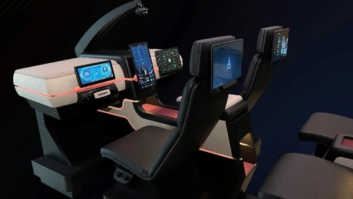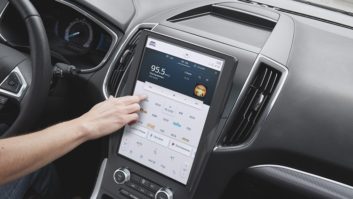This story first appeared in Radio World’s sister publication Twice.
Audio retailers will head for CES with the wind behind their backs, though the wind might not be as gusty as it was last year.

The $1,200 M2 from Voxx’s new Acoustic Research high-fidelity division will get a hearing at CES.
Most segments of the audio industry continue to grow, though at a slower pace than before, and the traditional component-audio segment – excluding soundbars – has begun to stabilize, marketers said.
That opens up opportunities for retailers and suppliers at CES, where dealers will find more brands of Bluetooth and wireless multiroom-audio speakers; more soundbar suppliers; soundbars equipped with Dolby Atmos object-based surround; a still-expanding selection of high-resolution audio gear; and new home theater equipment that takes advantage of the new object-based surround formats.
Also new: more wireless home theater systems incorporating a wireless hub with HDMI inputs and WiSA wireless technology to eliminate speaker wires.
Here’s what’s coming:
Bluetooth speakers: New suppliers will enter the market, and others will add new feature sets to differentiate their products in a market that continues to grow at a double-digit percentage rate, though the rate has slowed from year-ago lofty levels.
New suppliers include KEF, which has already begun shipping its first Bluetooth speaker.
At least one supplier will unveil a Bluetooth speaker with 100-foot range, joining Ultimate Ears in offering this feature, and at least one new model will come with an IP68 rating, making it dust-tight and able to survive continuous immersion in water at depths of 3 meters.
Dealers will also find a greater selection of speakers whose design enables multiple Bluetooth speakers to play back music simultaneously from the same Bluetooth source for parties or for big rooms. And more models will double as mobile-device power packs.
The products will enter a market that’s still posting double-digit percentage gains at retail, The NPD Group finds. For the 12 months ending October 2015, retail-level dollar sales rose 30 percent to $1.4 billion, down from the year-ago period’s 91 percent growth. Unit sales for the 12 months ending October grew 53 percent to 19.4 million, down from the year-ago 122 percent gain.

KEF’s first Bluetooth speaker, the $349 Muo, will appear at CES along with the first Bluetooth speakers from other market newcomers.
High-resolution audio: Industry promotion of high-resolution audio ratcheted up in recent months, and audio suppliers are expanding their product selections at CES to leverage the expected growth.
Suppliers will unveil a range of products that include high-res streamers and DACs, a two-channel stereo receiver, and new portables. High-res will also turn up in more in-dash car stereo head units. Dual will show its recently announced model, and at least three more companies will unveil their first models, joining Sony in the market.
Other new high-res products will include Pioneer’s previously announced high-res portable and stereo receiver, an expanded portable selection from at least one other supplier, the first high-res products from at least two audio companies, and expanded selections of such high-res products as DACs and DAC/headphone amps. More wireless multiroom-audio speakers will also turn with high-res capability from multiple suppliers.
One high-res newcomer is the Acoustic Research high-fidelity division of Voxx, which will show its $1,200 M2 portable player.
Soundbars: Demand is still on the rise, but sales are growing more slowly in units as household penetration rises and more slowly in dollars as average selling prices decline, analysts say.
At the same time, soundbars have broadened their appeal, morphing from TV-sound accessories into full-fledged audio systems with Bluetooth, HDMI switching, and in a growing number of cases, Wi-Fi multiroom audio. In the first half of 2015, Bluetooth and wireless-multiroom features were included in 77 percent and 4 percent, respectively, of units shipped in the U.S. in the first half of 2015, Future Source Consulting said.
Dealers at the show will find more soundbars with wireless multiroom audio and 4K-compatible HDMI switching along with some of the first models with HDMI 2.0 with HDCP 2.2 copy protection. At least one supplier will join Sony in offering such models.
Dealers will also find at least one more company joining Yamaha in offering a soundbar with Dolby Atmos object-based surround, though it won’t offer DTS-X as the Yamaha model does.
Also at the show, dealers will find at least two new soundbar suppliers, Riva and Zvox. The latter left the soundbar market in 2010 to focus on under-TV speakers.
Household penetration of soundbars, including under-TV speaker bases, exceeded 16 percent at the end of 2015, as consumers continued to desert home theater-in-a-box systems “in favor of this simpler solution,” said Future Source.
For its part, The NPD Group found retail-level dollar growth of 13 percent for the 12 months ending October 2015 to $885.6 million, down from the year-ago 34 percent gain.

Zvox’s $599 SB500 soundbar is due in the first quarter.
Traditional audio components: Segment sales, excluding soundbars, have begun to stabilize and could post slight growth in 2016. Audio suppliers hope to tap into the strongest niches with components that tap into the latest digital music sources or otherwise leverage new technology.
Traditional types of stereo products – including the first powered monitors from one company – will connect via USB to computers, and one company will add Bluetooth to a tube amp to deliver smartphone control. Updates to home theater audio products will come in the form of object-based surround compatibility, and at least two more wireless home theater systems will incorporate wireless WiSA technology to eliminate speaker cables.
Component-audio sales are beginning to turn around for a variety of reasons, suppliers say, including customer traffic generated by Ultra HD TVs and interest in object-based surround, which has begun appearing on a handful of Blu-ray discs and on Vudu video streams.
Wireless multiroom audio: The market is still relatively untapped despite years of growth, prompting more suppliers to enter the market and others to expand their selections despite slower growth.
At least four companies will enter the market, and many others will expand their selections.
The opportunity is there, Futuresource Consulting said. “Thirty-three percent [of consumers] want to be able to play the same music simultaneously throughout their home, yet only 8 percent of the wireless speaker market [including Bluetooth and Wi-Fi speakers] is currently multiroom.”
Because the market is dominated by Sonos, many suppliers at CES will try to differentiate themselves on sound quality or by adding the technology to audio components, not just to soundbars.
Though sales potential remains high, growth slowed in 2015, The NPD Group found. Sales of all networked speakers, including AirPlay and Sonos-like wireless-multiroom speakers, grew 11 percent in dollars to $275.4 million for the 12 months ending October 2015, down from the year-ago 70 percent dollar gain. Unit sales fell during that time by 9 percent to 1 million units compared to year-ago growth of 84 percent.
Multiroom audio “outside Sonos has not grown as fast as I expected,” NPD Group analyst Ben Arnold agreed. A key reason is customer confusion over the advantages of Wi-Fi versus Bluetooth. “There has not been as much consumer education as there needs to be,” he said.












